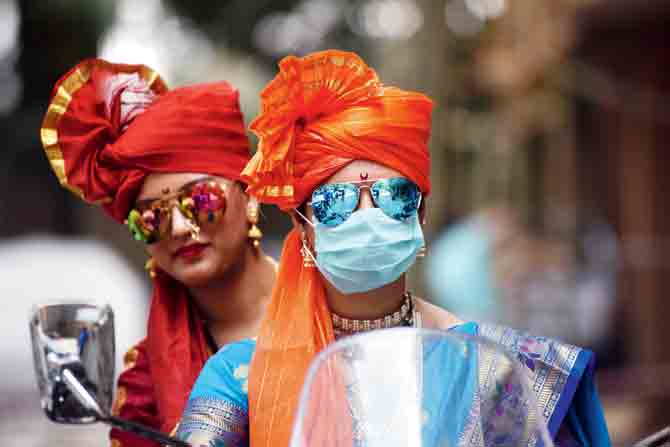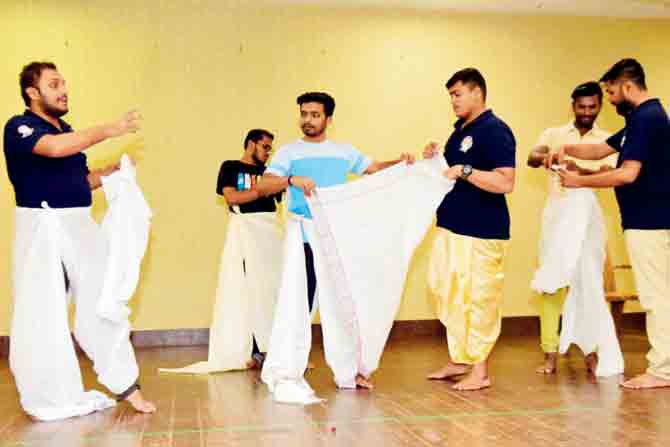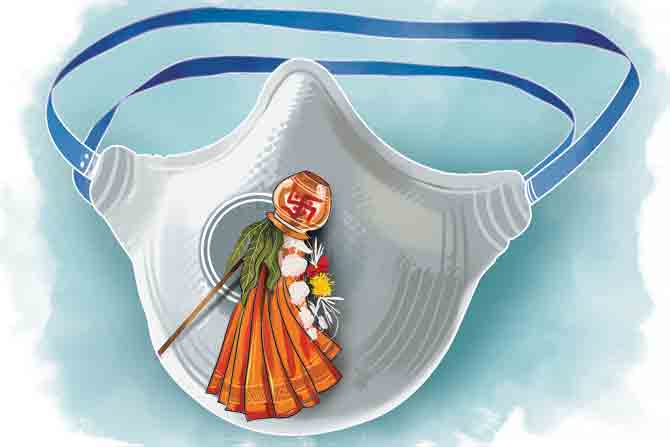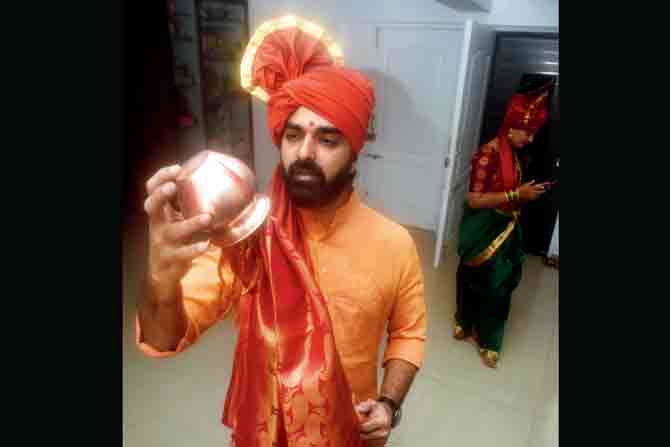Gudhi Padwa's rangoli makers and pugdi-nauwari specialists try to make sense of calling in the new year amid restrictions that make the festival more personal than public.

Swara Telawne and Bhushan Dugade prep for the Shobhayatra, where men and women from the community dress in traditional gear, and ride bikes through the streets of the city in a celebration of Marathi culture and identity. Pic/ Atul Kamble
 Noted poet Bahinabai Chaudhari's (1880-1951) Gudhi Ubharani (Mounting The Gudhi) defines good beginnings on the first day of the Chaitra month according to the lunisolar Hindu calendar.
Noted poet Bahinabai Chaudhari's (1880-1951) Gudhi Ubharani (Mounting The Gudhi) defines good beginnings on the first day of the Chaitra month according to the lunisolar Hindu calendar.
Gelsali geli aadhi
Aata padwa padwa
Tumhi yeryanyeryanvari
Lobh vadhawa vadhawa
ADVERTISEMENT
The bard urges everyone to start the year by spreading love, even among strangers, without holding on to old grudges. She refers to the festival as an occasion to foster social peace. At the literal level, her lines—aata pothara he ghar/sudhara re padzhadi (swab the house floor/ repair the damaged part)—appeal for house cleaning and plastering of walls and floors with cowdung.
But, this year, when Gudhi Padwa festivities have been scaled down due to restrictions on movement in light of the coronavirus outbreak, Bahinabai's verse applies in a fresh social context, more than ever before. With large gatherings forbidden, the political climate charged with factionalism, an amended citizenship law leaving a sizeable segment feeling threatened, Bahinabai's Gudhi Padwa message—Arey Utha Zhada Aang (get up and move your body)—asks us to shrug off old ways and consider new perspectives.
For years, Padwa has been a celebratory moment, an event for the family and community in the personal space where a gudhi placed on the terrace or window and srikhand-puri on the plate rounded off a state holiday. New clothes, an exchange of pleasantries like Gudhi Padwa, shubh bol gadhava (Say something that bodes well, you donkey!) characterised the day. Hereafter, Haldikumkum ceremonies shaped small congregations in which amba panha and chapha flowers were part of the etiquette. Social historian Dr AH Salunkhe's book, Gudhi Aaani Shankar Parvati traces the cultural evolution of the observance of Chaitra Shulka Pratipada or the first day after the new moon in the month of Chaitra. It was written five years ago in response to the question mark put on the cultural history of Gudhi Padwa. The writer says in the foreword that he never expected to write an explanatory text, and that it should not be construed as his personal endorsement of the religious rituals built around Padwa. Against the backdrop of the objections raised to the "Brahminical" stamp over the Chaitra Shulka Pratipada observance, Salunkhe quotes texts as old as the Mahabharata, Devi Bhagwat, Jyotirnirbandh and Kalidas' Kumarsambhav to prove that the festival was a universal experience for all castes. Setting aside extreme positions on Gudhi Padwa—some perceive Brahminical domination, others see it as a prestige showcase of Maharashtrian self-image—Salunkhe sees this as the onset of spring observed from pre-Vedic times; he shows evidence of the day's connect with the marriage of Lord Shiva and Parvati.

Priyanka Kolte rides the bike with Snehal Mahajan on pillion. They say they are looking forward to the Maharashtrian New Year, but with precautions in place. Pics/ Atul Kamble
In Maharashtra, Gudhi Padwa grew dominant in the public realm 22 years ago when social worker Abasaheb Patwari initiated the Padwa Swagat Yatra in Dombivli, a rally showcasing Marathi culture, folk arts, female power, apparel finery, headgears, drummers and lezim dancers. Soon, the model was picked up in Thane, Vile Parle and Girgaum. Not all rallies have enjoyed popular patronage over the years; Girgaum so far, has been the nerve center of Gudhi Padwa-related art and activity. Nearly 15-odd Shobhayatra traditions are thriving in neighbourhoods as diverse as Walkeshwar and Kalwa. Women take centerstage in the rallies, clad in nauwari sarees riding Royal Enfiled bikes, with the nath or traditional pearl nose ring intact. This photo opportunity has been accepted as a stock image of Padwa in national consciousness.
These yatras are citizen initiatives, but they invariably have socio-political sponsors. For instance, the two Girgaum rallies which run simultaneously (often quarrelling with the other over route congestion) from Phadke Ganpati Mandir to Chira Bazaar, enjoy the patronage of heavyweight forces including the RSS-backed Swami Vivekanand Yuva Pratishthan and Shiv Sena. The latter is openly political; this year it was going to be a mega show of 25 Republic Day-styled floats. With Sena leading the state government and a Thackeray at the wheel, the Padwa yatra (which now stands cancelled) was planning to focus on government priorities like the plastic ban, the conservation of forts, loan waivers for farmers and the promotion of Marathi.

Nauwari saree and dhotar draping session at a pre-Gudhi Padwa workshop by Swami Vivekanand Pratishthan being held at Sharada Mandir High School, Gamdevi last week. Pic/ Bipin Kokate
Unlike the Sena rally, the Pratishthan rally which is now in its 18th year, has been postponed to April 26 to mark Akshay Tritiya. But on March 25 or Gudhi Padwa day, a Ganesh pooja and gudhi pooja will go on as usual with a limited hundred people in attendance. After the pooja, volunteers (who were otherwise to participate in the rally and present a percussion non-verbal enactment of Ramayana) will go door-to-door in Girgaum and spread awareness about the coronavirus. As one of the organisers, Parag Vedak, says the festive spirit will not die; a virus should not be allowed to dampen enthusiasm. In fact, the Pratishthan succeeded in creating a pre-Gudhi Padwa buzz which included nauwari/dhotar draping workshops and Pranayam-Suryanamaskar orientation. Their Maha Rangoli sessions will also go on, as will the Sambhaji Maharaj Balidan Din on March 24, which commemorates Chhatrapati Sambhaji Raje Bhosale's heroic death. If you fear that such a commemoration might encourage a congregation, Vedak assures that the crowds will be within prescribed limits. "The Maharashtra State Assembly has 288 members when in session. If that is not a mass gathering, we will be well within limits."
Drummer Nikhil Kalwint, a member of the Girgaum Dhwaj Pathak group, is happy about the celebrations shifting to April 26. An engineer with Tech Mahindra, he along with 400-odd volunteers of the percussion team usually begin rehearsals in late December. Since Girgaum doesn't offer a large space for the drills, drummers aged
15 to 45 practice in weekend batches at a Lower Parel facility. This year, the drummers get a longer practice period.

Illustration/Uday Mohite
Malad-based apparel designer Vaishali Naik, who tailors ready-to-wear nauwaris has adjusted well to the new deadline. For five years, she has been fashioning sarees for "women on the move". Her firm, Chaar Chaughi specialises in the "natural look" ready-to-wear nauwari, for which she has received a thousand orders this year. Her charges (R500 to R1,000) vary according to styles like Mastani and Dev Sena. She is popular for facilitating a graceful drape, and her clients come from as far as the United States. As festivals are joyous occasions, and they come with their share of chores, Chaar Chaughi's nauwari factors in the reality that women care about how they look despite the extra domestic duties on hand.
Shraddha Srinivas Gharat, 49, of Samrat Dresswale is happy that Padwa will be celebrated this year in an exam-free April. Her incessantly ringing phone demonstrates the large-sized stitching orders of Padwa-special pugdis she receives. Pudgis, worn by the young and the old, help underline the Marathi credentials of the participants and spectators in the processions. "It is somewhat reminiscent of the Peshwa rule and a thing to feel happy about," says Gharat. Her company also specialises in the saffron flags. This year, they have received orders from across Maharashtra for thousand flags, intricate, zardozi-embroidered, silk-made, etc. A temple in Satara has ordered for a 64-metre record-long saffron bunting for Gudhi Padwa. While a swastika symbol is the basic requirement on the flag, some customers ask for more elaborate lettering.
Sameer Gujar, 33, popularly known as Omkar Phetewala, has spent the last two months in prep. He is famed for tying a pheta in one minute, whether saffron cotton or the silk saree variety. Gujar ties around 12 types of phetas (Marwari, Kathiawari included) on regular days, but the Gudhi Padwa season is marked by the six types of Maharashtrian phetas he is a master at. He charges Rs 1,000 for one real-time pheta tethering session. "For me, the March calculations have gone haywire. The mood is also affected," he admits.

Yogesh Dugade adjusts the gudhi at his Bhandup residence and hopes to keep his spirits up knowing that the celebrations will take a hit due to the precautionary measures in place following the coronavirus outbreak
Like Gujar, rangoli designer Sucheta Pingte's business has scaled down radically. She is known for the live sessions where she uses coloured rice, dry flour, and coloured sand to etch festive motifs like the peacock and the gudhi. Her services are booked in advance by temple trusts and social-political groups. One of her earlier Maha Rangoli sessions at Borivli's Pepsi Ground extended to 25,000 square feet, which required over 1,500 kg of colour and creative collaboration between 25 artists. But these are mere memories. This year, she will draw a small design at the entrance of a public temple near her Kalwa residence. There is no ban on that.
Sumedha Raikar-Mhatre is a culture columnist in search of the sub-text. You can reach her at sumedha.raikar@mid-day.com
 Subscribe today by clicking the link and stay updated with the latest news!" Click here!
Subscribe today by clicking the link and stay updated with the latest news!" Click here!







